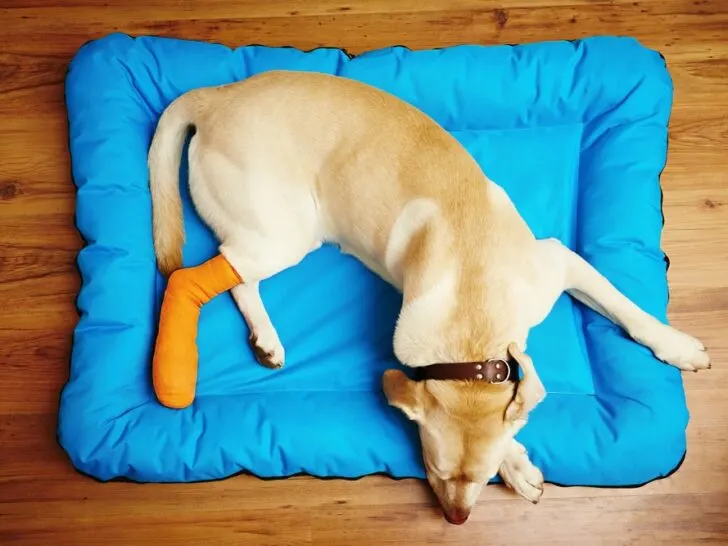Medically Reviewed by Dr. Majid Tanveer, DVM
Limping in dogs is a common ailment, but it’s no less worrying for pet owners. While often caused by common conditions, dog lameness can be diagnosed and treated successfully.
Are you concerned about your dog’s sudden lameness? Have you noticed that your pup has been walking with an uneven gait recently? If so, it is essential to understand the potential causes and available treatments for dog lameness.
An assortment of problems can cause lameness in dogs, from aging and excessive weight to malignancy or trauma. Often, limping results from joint inflammation, injury, or arthritis, which can be treated with restorative measures such as medicine, physical therapy, or even surgery, depending on the underlying issue.
As a professional veterinarian and lifelong dog owner, I always recommend a complete evaluation of your pup if they suddenly start limping. Let’s take a closer look at the causes, symptoms, and treatments for dog lameness.
What is Lameness in Dogs?

Lameness in dogs is an abnormal gait caused by pain or stiffness that prevents them from properly using one or more of their limbs.
Lameness in dogs can be categorized into musculoskeletal, neural, and systemic types:
- Musculoskeletal lameness arises from abnormal conditions or injuries to the muscles, tendons, bones, ligaments, and joints. Ruptured ligaments, muscle tears, or hip dysplasia are some of the most common causes of muscular lameness.
- Neural lameness is caused by damage to the nervous system, such as a stroke or neurological condition.
- An underlying illness causes systemic lameness in the body that affects how the limbs move, like Lyme disease or metabolic disorders.
Lameness in dogs can range from mild to severe, varying between acute and chronic symptoms.
Acute Lameness
It occurs suddenly after an injury or trauma, such as a fall or blows to the limbs. In these cases, the lameness may last for a few days or weeks before full recovery.
Chronic Lameness
It develops gradually over time and is often caused by degenerative diseases or long-term injuries. In these cases, the lameness may persist for months or years, leading to decreased quality of life.
10 Causes of Lameness in Dogs

Dog lameness can be caused by various issues, from minor injuries to serious illnesses. A simple thorn in their paw or more severe conditions such as arthritis or hip dysplasia can all cause limpness.
It may even be the first symptom of more significant health issues in some cases, but with timely diagnosis and treatment, your pup can soon return to its normal active lifestyle.
Here are some notable causes of canine lameness:
1. Trauma or Injury
A distressing incident or an injury, like a car accident, sports-related injury, or even simply tumbling down the stairs, can cause your pup to suffer from torn muscles and tendons in his legs. Signs around the affected area may include swelling, bruising, heat, limping, etc.
Punctures/cuts to the foot, broken/overgrown nails, burns, frostbite, insect stings/bites, or bruises may also cause limping. It could indicate pain if your dog constantly licks or cheats on their legs.
2. Joint Inflammation
Lameness can originate from inflammation in any of the joints, including those in your pup’s hips or knees. This often results due to wear and tear on the joint. However, the infection may be to blame as well.
The symptoms arise with painful swelling that causes limping and signs like stiffness or difficulty moving upstairs/inclines and jumping onto furniture.
3. Osteoarthritis
Osteoarthritis is a degenerative joint disease that can cause pain, stiffness, and lameness in dogs over time. This disorder occurs when the protective cartilage surrounding bones erodes, causing the two uncovered surfaces to rub together painfully.
Depending on its progress, treatment may include medications, physical therapy exercises, or even joint replacement surgery. Regardless, these options can help relieve your pup from his discomfort and loss of mobility.
4. Hip Dysplasia
This inherited condition occurs when a dog’s hip joints are malformed, leading to lameness and pain. While there is no cure for hip dysplasia, medications, and physical therapy can help alleviate the symptoms. In severe cases, surgery may be necessary to correct the issue.
5. Elbow Dysplasia
Elbow dysplasia is an inherited ailment that can cause extreme discomfort and lameness in aging dogs. This condition causes the elbow joint to develop abnormally, resulting in bones rubbing together aberrantly and impaired movement.
Elbow dysplasia is a prevalent disease among large breed puppies such as German Shepherds, Labrador Retrievers, Rottweilers, or Newfoundlands – leaving their owners with additional care duties for their furry friends.
6. Disc Disease
This condition occurs when the discs between the vertebrae become displaced or degenerate due to age or trauma, resulting in lameness and severe pain. This type of injury is often accompanied by paralysis and may require extensive treatment.
7. Tumors and Cysts
Sometimes, tumors and cysts can form in your pup’s bones or soft tissue, resulting in pain and lameness.
These growths can cause discomfort if they occur near a joint, potentially requiring surgical removal depending on the size and location of the growth.
8. Infections
Often, your pup may limp without any other visible symptoms; however, infections such as Lyme disease, Rocky Mountain Spotted Fever, and Ehrlichiosis can all be the underlying cause.
In severe cases, these illnesses can even affect the nervous system and damage the spinal cord to a point where paralysis in limbs is observed.
9. Luxating Patellas (Kneecap Dislocation)
When the kneecap moves from its place, it causes severe pain and causes cruciate ligaments to be broken, resulting in lameness. It may cause skipping limbs which occurs frequently. This is common among small breeds like Pomeranians, Yorkshire terriers, and Chihuahuas.
10. Degenerative Myelopathy
Degenerative myelopathy is an autoimmune disorder that profoundly affects the canine nervous system. The cells responsible for transmitting signals between the brain and spinal cord are weakened, resulting in decreased mobility of hind limbs.
Inevitably, this leads to gradual lameness before inner stability becomes lost altogether – with dogs losing capability in their back legs over time due to degenerative myelopathy’s destructive nature.
Overall, lameness in dogs can be caused by a variety of issues. It is essential to recognize the signs and seek medical attention if your pup exhibits any lameness or discomfort in its legs. By doing this, you can help provide relief for your pup and reduce the risk of further injury or damage.
What Does a Limping Dog Look Like?
Similar to humans, our canine friends can experience a range of traumas or ailments that result in limping. They may carry their weight on all fours legs but with an abnormal gait or lift the injured paw when walking – even dragging it along as they go.
Limping and lameness vary from intermittent to persistent, depending upon the seriousness of the injury/illness. Some of the most common signs of lameness in dogs include:
- An inability to stand on the affected limb
- A persistently held elevated limb
- Uncoordinated gait with limping or hopping
- Reduced range of motion at a joint
- Difficulty in sitting, rising, and jumping
- Refusal to put weight on the affected limb
- Visible deformity of the affected limb, like a fracture
- Swelling or redness around a joint
- Discomfort when touched
- Abnormal posture while standing, walking, or running
- Reduced activity levels
- Excessive licking, chewing, or biting at the affected area
- Muscle atrophy or wasting in the affected leg
- Visible limp when walking
If you notice these symptoms in your pup, they may suffer from lameness. Taking steps quickly for a proper diagnosis and treatment plan is essential.
Treatment of Dog Lameness

The first step in treating dog lameness is identifying the underlying cause. This can often be done through physical examination and diagnostic tests such as X-rays and other imaging technologies.
Treatment for dog lameness will depend on the underlying cause. It can range from conservative measures such as rest, medications, physical therapy, and orthopedic support to more extreme measures such as surgery.
It is important to note that dog lameness may not be an isolated issue — it could indicate a more significant problem, such as arthritis or a joint disorder. If your pup has been diagnosed with an underlying condition such as arthritis, additional treatments and therapies are available to help manage the associated pain and inflammation.
In addition to medical treatment, pet owners can also provide extra support through diet and lifestyle changes. Increasing exercise levels or introducing supplements can benefit pups with joint pain and stiffness.
How to Treat Your Dog’s Lameness at Home
When you spot your pup limping, stay calm and assess the situation. Carefully inspect their paws and take action accordingly. If an injury or something more serious is suspected (such as a foreign object stuck between the pads), promptly tend to it for first aid and safety.
Small Objects (Thorns, Pebbles, etc.)
- Carefully remove any foreign objects stuck in your dog’s paw pads using tweezers or a small brush.
- Gently wash the area with an antibacterial soap.
- Apply a cold compress or ice pack to reduce swelling if there is inflammation.
Injured Paw Pads (Torn or Scraped Skin, Broken Nails)
- Control bleeding by applying pressure to the area with a clean cloth or gauze.
- Rinse the wound with an antiseptic solution and warm water.
- Dry the area with a gauze or neat cloth or towel.
- Apply a thin layer of antibiotic ointment to promote healing and prevent infection.
Cracked Nails (Splitting or Flaking of the Toenail)
- Trim the nail back to healthy tissue and apply a moisturizing balm or ointment.
- If you detect infection, apply an antibiotic ointment to guard against further complications.
Bruising and Swelling (Bruises from Impact, Swollen Joints)
- Apply a cold compress with ice or frozen vegetables wrapped in a towel to reduce swelling.
- To reduce inflammation, your dog may find relief with NSAIDs which are safe for dogs.
Trauma (Injuries from Falls, Car Accidents, or Other External Forces)
- Seek immediate medical attention if the injury is severe.
- Apply a cold compress to reduce swelling.
- Consider using a supportive bandage for any fractures, sprains, and strains.
- If necessary, use pain relief medications to reduce discomfort.
- Keep your pup calm and restrict their activity until the injury has healed.
By following these steps, you can help your pup find relief from their lameness and get them back to running around like they used to!
Remember that your vet is the best source of information regarding canine health trends and dog lameness treatments. With the correct diagnosis and treatments, your pup can return to feeling its best in no time.
Pet Care Tip: If your pup suffers from a permanent lameness or leg fracture, you can learn how to make them a PVC Dog Wheelchair at home, thanks to this video! Check it out now and start making your furry friend more comfortable.
Frequently Asked Questions
How To Move An Injured Dog?
When moving an injured dog, take extra care to prevent further harm. Lift him with two people or use a stretcher/blanket for bigger dogs. Keep the head/neck stable and avoid sudden jerks or turns. Make the journey short and keep stops/turns to a minimum. Be gentle throughout!
How Long Does It Take For A Dog To Recover From Lameness?
Recovery from lameness in dogs varies greatly depending on the severity of the injury. Low-level soft tissue injuries and mild sprains typically take one to two weeks; moderate muscle strains, up to four weeks; while more severe cases could take months or longer.
How Can I Strengthen My Dog’s Weak Legs?
Exercise and weight management are essential for strengthening your dog’s legs. Start gradually and increase intensity when your dog is ready. Low-impact activities such as walking on a leash, swimming, or hydrotherapy can help build muscle strength over time.
How Can I Do Leg Physiotherapy At Home?
Home physiotherapy for your dog may include stretching, massage, and range-of-motion exercises. Stretching can help reduce muscle tension and improve joint flexibility. Massage helps to increase circulation and is beneficial for relaxation. Range of motion exercises involves appropriately manipulating the joints to maintain their full range of movement.
